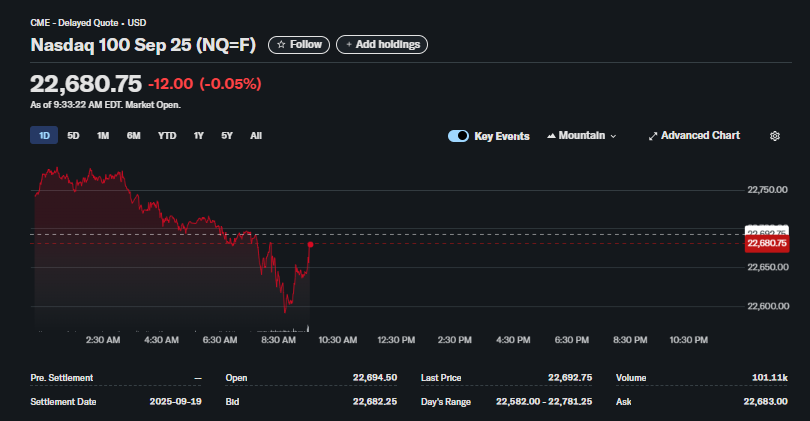Nasdaq 100 Futures Stage Stunning Rebound, Shaking Off Early Weakness in a Major Show of Market Resilience

NEW YORK – The technology-focused Nasdaq 100 futures contract (NQ=F) showcased incredible resilience during early trading hours, staging a powerful V-shaped recovery that completely erased a steep pre-market decline. As of 9:33 AM EDT, the September 2025 contract was trading at 22,680.75, down a negligible 0.05%, a figure that belies the dramatic buyer-led rally that unfolded just before the U.S. stock market open.

The session began with selling pressure that pushed the futures down to a low of 22,582.00. However, this dip proved to be a powerful magnet for buyers. In a classic “buy the dip” scenario, a wave of buying interest entered the market, driving the index futures up by nearly 200 points from the session’s bottom. This decisive rebound is a strong technical signal, suggesting that underlying confidence in the technology sector remains robust.
High Volume Confirms Investor Conviction
The powerful reversal was not a low-volume anomaly. With over 101,000 contracts already traded, the session is marked by significant participation, lending credibility to the rebound. When a market reverses on high volume, it indicates that a large number of participants are actively shifting their positions, in this case showing a strong conviction to defend key technical levels and push prices higher.
This price action suggests that despite any overnight jitters or macroeconomic concerns, investors are continuing to view the technology leaders of the Nasdaq 100 as a core holding. The ability of the market to absorb significant selling pressure and rally back so forcefully often sets a positive tone for the cash session, hinting at potential strength for tech stocks throughout the day.
What This Means for Investors
For market watchers and investors, this morning’s price action is a textbook example of market strength. The Nasdaq 100 futures not only held a key support level but also demonstrated that demand remains high. The day’s range, spanning from 22,582.00 to 22,781.25, illustrates a highly dynamic but ultimately resilient market.
As the global economy continues to navigate uncertainty, the performance of the Nasdaq 100 is seen as a key barometer for investor sentiment. Today’s powerful rebound from the lows signals that the bullish trend remains intact and that market participants are eager to seize on any perceived discounts in the world’s most innovative companies.
Frequently Asked Questions (FAQ) about Nasdaq 100 Futures (NQ=F)
Here are answers to more than 10 common questions about the Nasdaq 100 and its futures contracts.
1. What is the Nasdaq 100 Index?
The Nasdaq 100 is a stock market index that includes 100 of the largest non-financial companies listed on the Nasdaq stock exchange. It is heavily weighted towards technology companies like Apple, Microsoft, Amazon, NVIDIA, and Google.
2. What are Nasdaq 100 futures (NQ=F)?
Nasdaq 100 futures (ticker symbol: NQ) are a type of financial derivative contract that allows investors to speculate on or hedge against the future value of the Nasdaq 100 index. The “=F” signifies that it is a futures contract.
3. What does “Sep 25” in “Nasdaq 100 Sep 25” mean?
This indicates the contract’s settlement or expiration period. A “Sep 25” contract is an agreement to buy or sell the Nasdaq 100 index at a predetermined price, with the contract expiring in September of 2025. The image specifically shows a settlement date of 2025-09-19.
4. Why did the futures drop and then recover so sharply?
This “V-shaped” recovery is often a sign of strong market sentiment. The initial drop could be due to overnight news, economic data, or automated trading programs. The sharp recovery indicates that buyers saw the lower prices as an attractive entry point and stepped in with force, overwhelming the sellers.
5. How do Nasdaq futures relate to the Nasdaq 100 cash index (NDX)?
Futures trade nearly 24 hours a day, five days a week, while the cash index (NDX) only trades during regular U.S. market hours. The futures market often leads the cash market, with its price action providing a strong indication of how the NDX will open.
6. What does the price level of “22,680.75” represent?
This is the current price of the futures contract, which reflects the market’s real-time expectation of the Nasdaq 100 index’s value.
7. Why is the trading volume important?
Volume represents the number of contracts traded. The high volume of over 101,000 contracts confirms the significance of the price recovery. A strong move on high volume is considered more credible and powerful than a move on low volume.
8. What is the CME?
The image notes “CME – Delayed Quote.” CME stands for the Chicago Mercantile Exchange, which is one of the world’s largest financial derivatives exchanges where futures contracts like the NQ are traded.
9. What does “Delayed Quote” mean?
It means the price data shown is not in real-time but is delayed by a short period (typically 10-15 minutes) for users who do not have a paid, real-time data subscription.
10. What does the “Day’s Range” of 22,582.00 – 22,781.25 tell us?
This range shows the lowest and highest prices the futures contract has traded at during the current session. A wide range indicates high volatility.
11. What is the difference between “Open” and “Pre. Settlement”?
The “Open” price (22,694.50) is the price at which the contract began trading for the current session. The “Previous Settlement” or “Last Price” (22,692.75) is the official closing price from the prior trading day.
12. Can I invest directly in Nasdaq 100 futures?
Yes, but it requires a brokerage account that supports futures trading. Futures are leveraged instruments and carry a high degree of risk, making them more suitable for experienced traders. Other investors often gain exposure to the Nasdaq 100 through ETFs like QQQ.

